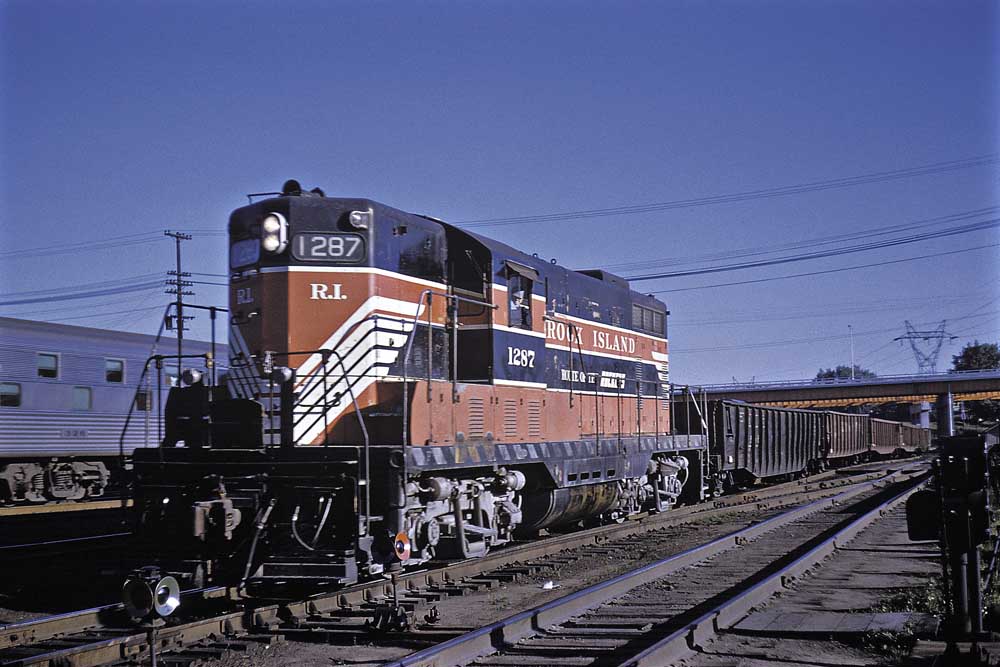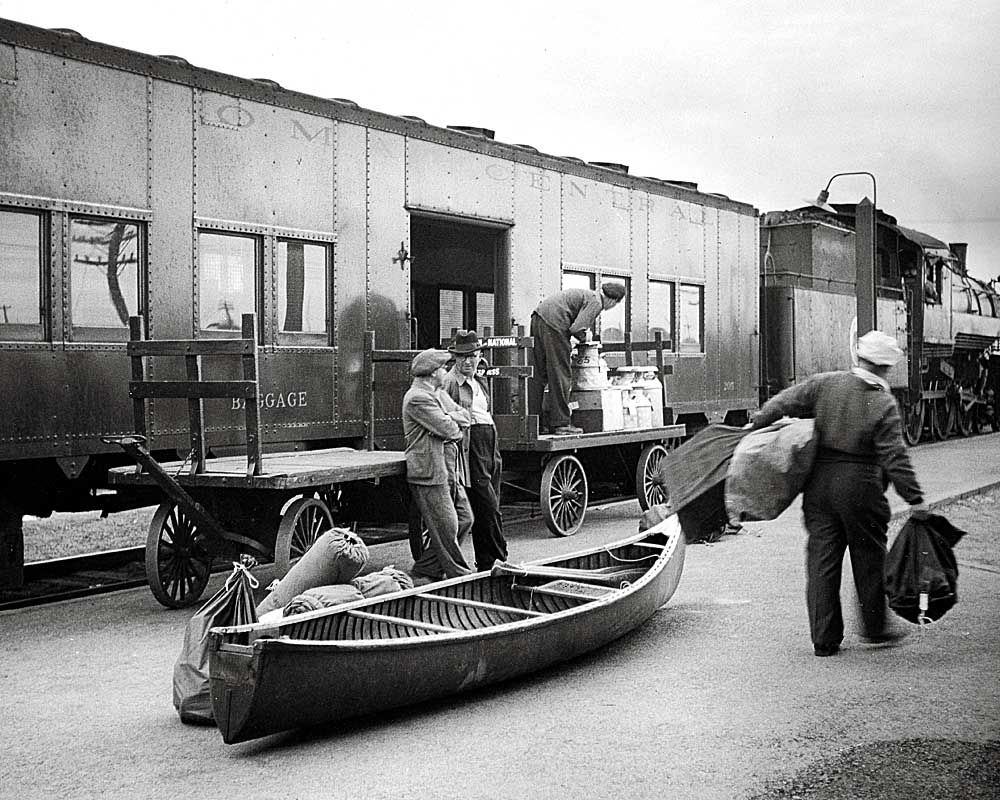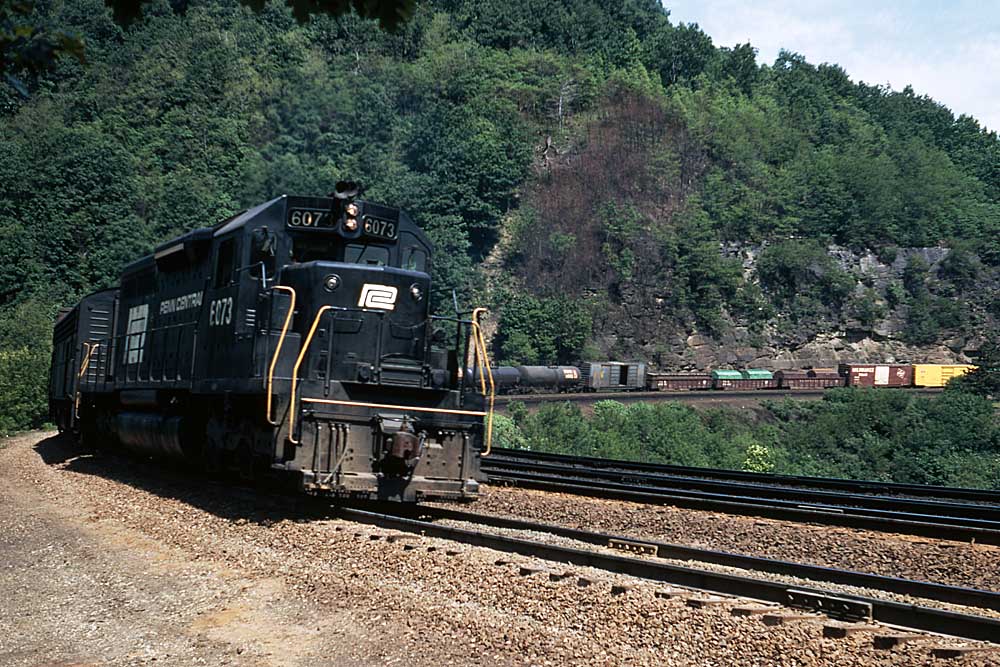Lake Erie & Western
The Lake Erie & Western Railway was formed in 1879 to consolidate smaller railroads between Fremont, Ohio, and Bloominton, Ill. In 1880, the LE&W extended its line east from Fremont to Sandusky to replace boats on the lower stretches of the Sandusky River and teamed up with the Lake Shore to offer through freight and passenger service. The Lake Shore’s lack of cooperation in the matter of westbound traffic was the reason LE&W’s backers built the Nickel Plate.
The LE&W nearly died during the 1880s, but the discovery of natural gas and oil along the line in Ohio and Indiana revived it. In 1887, it was reorganized and extended west to Peoria, Ill. That same year, it acquired a Michigan city-Indianapolis line that crossed its main line at Tipton, Ind., and in 1890, acquired a line from Fort Wayne to Connersville and Rushville, Ind., a line that crossed the Lake Erie & Western at Muncie. In 1885, the LE&W proposed assembling a line to the East Coast by using the Reading, the Buffalo, Rochester & Pittsburgh, and the Pittsburgh, Akron & Western, a former narrow gauge line from Akron to Delphos, Ohio. The PA&W was reorganized that year as the Northern Ohio and leased to the LE&W.
In 1899, the LS&MS purchased a minority interest in the LE&W, and proceeded to let it decline gently. In 1920, LE&W sold the Northern Ohio to the Akron, Canton & Youngstown.
Toledo, St. Louis & Western
The Toledo, Delphos & Indianapolis was organized in 1877 and that year opened a three-foot gauge line a few miles north from Delphos, Ohio. Two years later, it became part of the Toledo, Delphos & Burlington, a consolidation of four railroads. The TD&B had as its goal a three-foot-gauge line from Toledo to Burlington, Iowa. The line was opened from Toledo to Kokomo, Ind., in 1880. It began extending south, buying up railroads to form a line south through Dayton to Cincinnati and Ironton, Ohio. Then it got caught up in a proposal to assemble a narrow-gauge line all the way from Toledo to Mexico City. The line was opened from Toledo to East St. Louis, Ill., in 1883, and the company collapsed soon afterward. The lines south of Delphos to Cincinnati and Ironton were spun off to eventually become standard gauge pieces of the Cincinnati, Hamilton & Dayton, the Pennsylvania, and the Detroit, Toledo & Ironton. The Toledo-East St. Louis line was nearly dead when gas and oil were discovered along the line. It was reorganized as the Toledo, St. Louis & Kansas City Railroad, and adopted a clover leaf as its emblem. Trackage east of Frankfort, Ind., was converted to standard gauge on June 25, 1887; the remainder of the line was converted two years later. The road developed a good freight business, particularly in eastbound livestock and perishables received from connections at East St. Louis.
The TStL&KC went bankrupt in 1893. The court proceedings included William Howard Taft as judge and Benjamin Harrison as counsel. The railroad was sold to its bondholders and became the Toledo, St.Louis & Western. It continued as a fast freight line, particularly in competition with the Wabash. In contrast to many midwestern roads, the TStL&W got along well with neighboring interurbans, even filing joint passenger tariffs. In 1903, the Clover Leaf acquired a half interest in the Detroit & Toledo Shore Line. In 1907, it purchased control of the Alton. the TStL&W issued bonds to finance the purchase; interest on the bonds brought on another receivership in 1914.
Nickel Plate
In 1923, the Nickel Plate, the Lake Erie & Western, and Clover Leaf were consolidated as a new New York, Chicago & St. Louis Railroad. On the recommendation of Alfred H. Smith, president of the NYC, the Van Sweringens went after the Chesapeake & Ohio for its coal traffic, and the Pere Marquette for its automobile business. In 1925, the New York, Chicago & St. Louis Railway was incorporated to lease and operate the Nickel Plate, C&O, PM, Erie, and Hocking Valley. The railroad industry was in favor of the merger, but a small group of C&O stockholders fought it. In 1926, the ICC rejected the petition on financial grounds; it was in favor of it from the standpoint of transportation. Then the Ven Sweringens tried again in 1926: C&O applied to acquire PM, Erie, and Hocking Valley. The ICC rejected that in 1929.
The Van Sweringens moved Bernet to the Erie and installed in his place Walter Ross, who had been president of the Clover Leaf. He engineered an about-face for NKP’s passenger service, which for years had been operated on the assumption there was no sense trying to compete with the NYC. Ross went after the long-haul passenger with comfort and personal service. The passenger renaissance lasted only until 1931, when the Depression occasioned cutbacks.
Nickel Plate came under Chesapeake & Ohio management in 1933, and Bernet was back in the presidency. He initiated a scrap drive to finance rebuilding of the Clover Leaf district, and ordered the first 15 of a series of big 2-8-4 Berkshires that eventually numbered 80 to upgrade the road’s freight power. The design of the new locomotives drew heavily on Chesapeake & Ohio’s 2-10-4s. Other improvements of the late 1930s and the war years were strengthening the bridges east of Cleveland, introducing Centralized Traffic Control, and upgrading track and bridges on the Lake Erie & Western and the Clover Leaf to permit the Berkshires to work to Peoria and Maidson (East St. Louis), Ill.
Nickel Plate resumed its own management in December 1942; Chesapeake & Ohio attempted merger in 1945, but NKP stockholders objected. Dieselization of passenger service began in the late 1940s, but freight continued to roll behind steam. In 1948, Nickel Plate tested a set of Electro-Motive F3s and immediately ordered 10 more Berkshires (they proved to be Lima’s last steam locomotives). A four-unit set of F3s could outperform the 2-8-4s, but fuel costs were greater; a Berkshire developed greater horsepower at speed than a three-unit set-and at speed was where Nickel Plate used most of its horsepower.
NKP also tested General Electric’s gas turbine-electric, and EMD painted a pair of F7s blue and gray, like the PAs, for a demonstration on the former LE&W. Freight diesels finally began to arrive in the form of GP7s in 1951, but steam dominated main-line freight service until the business recession of 1957 and 1958. Nickel Plate was one of the last U.S. railroads to operate steam, and two of the Berkshires, 759 and 765, remained active in excursion service.
In 1946 and 1947, NKP purchased about 80% of the stock of Wheeling & Lake Erie, and on Dec. 1, 1949, NKP leased the W&LE. The Wheeling served the steel and coal area of Ohio, and orginated much of its tonnage, in contrast to NKP, thus providing balance to the NKP’s bridge-route freight business.
For years, NKP’s principal freight competitors had been the Erie and the Wabash. After 1954, the New York Central under Alfred Perlman began to become a lean, fast railroad. The Lackawanna proposed merger with Nickel Plate; NKP management rejected the union. When Lackawanna merged with Erie, it disposed of a large block of NKP stock. Norfolk & Western merged the Virginian, and the New York Central and the Pennsylvania announced their engagement. Nickel Plate, suddently unattached, looked around, set up through freight trains with Lehigh Valley, and began merger negotiations with Norfolk & Western. On Oct. 16, 1964, N&W merged the Nickel Plate.













